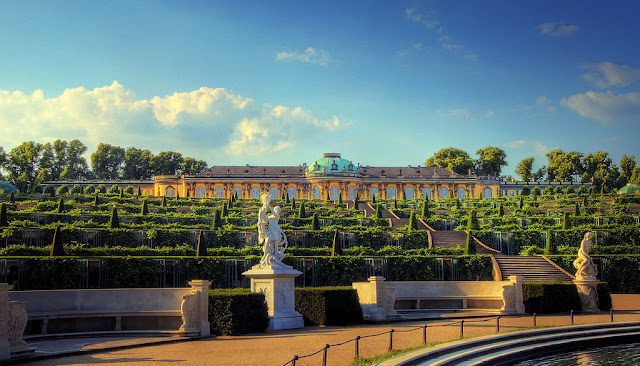 |
| Sans Souci. Image: Flickr |
The Prussian House of Hohenzollern was one of Europe’s most
illustrious and powerful dynasties. Originally margraves of Brandenburg and dukes
of Prussia, they were elevated to become Kings of Prussia in 1701, and later
on, Emperor of the German Empire in 1871. However, the Hohenzollern’s grip on power
ended after Germany's disastrous defeat in World War I in 1918 and the German
Revolution. Nevertheless, their legacy
remains to this day with the grand residences and palaces they built, all of
them now considered historical and heritage treasures.
Stadtschloss/City Palace, Berlin
 |
| Stadtschloss or the City Palace in Berlin. Image: Wikimedia Commons. |
The Stadtschloss or the City Palace in Berlin was home to
the electors of Brandenburg and later served as the principal residence and
winter residence of the Kings of Prussia from 1701 to 1918. After the monarchy
was toppled in 1918, the palace served as a museum. It was, however, heavily
damaged by Allied bombing in World War II. Rather than getting repaired, the
German Democratic Republic decided to demolish the palace in 1950 despite heavy
criticism.
Königsberg Castle
 |
| Königsberg Castle. Image: Wikimedia Commons. |
Once a famous landmark of the East Prussian capital,
Königsberg, the castle, however, fell into heavy damage and burned down after
the bombing by the Royal Air Force at the height of World War II in 1944.
Neues Palais, Potsdam
 | |
|
Frederick II, later the Great, had the penchant for building
grand residences. His own, lavish taste was stamped in the palaces he built, hence,
the Frederician rococo evolved. He started building Neues Palais in 1763, after
Prussia’s success in the Seven Years' War. It was finished in 1769 and was
hailed as the last great Prussian baroque palace. After his death, though, the
palace fell into disuse but stands to this day as a reminder of his remarkable
taste.
Marmorpalais (Marble Palace), Potsdam, near Berlin
 | |
|
Marmorpalais stands on the extensive Neuer Garten on the shores
of the Heiliger See. Commissioned by Frederick William II, this Neoclassical palace
was a favorite home for generations of Hohenzollerns until the monarchy was
abolished. It later served as a military museum during the Communist regime and
is now opened to the public.
Babelsberg Palace
 | |
|
Sitting on the eponymous park and quarter of Potsdam,
Babelsberg Palace was the summer home of the future Emperor William I and his
wife, Augusta. In 1990, Babelsberg Palace was declared a UNESCO World Heritage
Site.
 | |
|
Cecilienhof was the last palace built by Hohenzollerns, the
palace served as the venue of the Potsdam Conference in 1945, where leaders of
the Great Powers met to decide on the fate of the world after World War II. Cecilienhof
has been part of the Palaces and Parks of Potsdam and Berlin UNESCO World
Heritage Site since 1990.
Oranienburg Palace, Oranienburg
 | |
|
Oranienburg is considered the oldest Baroque palace in Brandenburg
and was design with the Dutch style in mind.
The Royal Palace, Wrocław, Poland
 | |
|
The Royal Palace in Wroclaw, Poland, was once home to Heinrich
Gottfried von Spätgen, chancellor of Bishop Francis Louis of Neuburg. It was
purchased by King Frederick the Great in
1750, after Prussia annexed Silesia,
transforming it into a royal abode.
Stolzenfels Castle, Koblez, Rhineland-Palatinate
 | |
|
Stolzenfels Castle was once a medieval fortress castle near
Koblenz on the left bank of the Rhine. It was a complex of ruins when it was gifted
to Prussian Crown Prince Frederick William in 1823, which he rebuilt and turned
into a 19th-century palace in the Gothic Revival style. The castle is now a UNESCO
World Heritage Site.

.png)




0 Comments